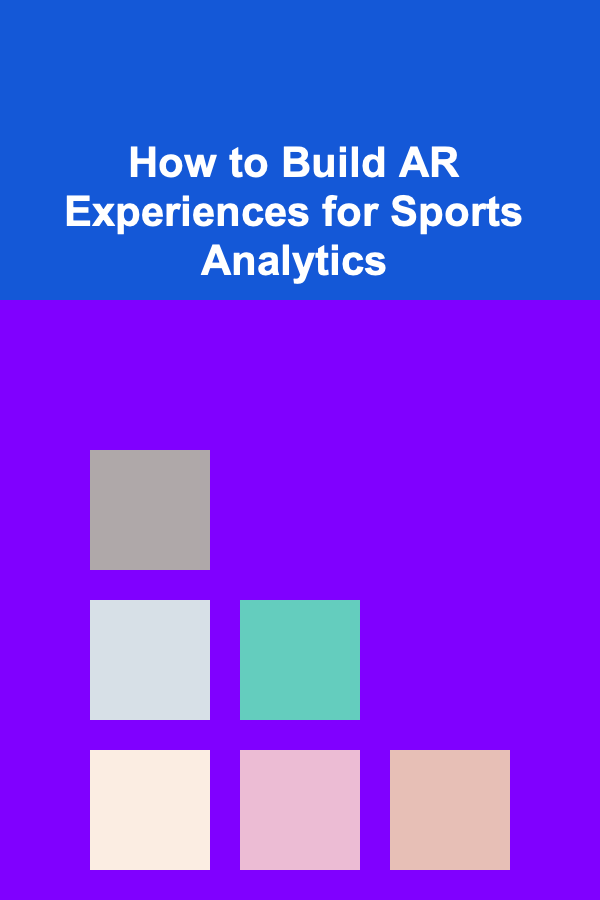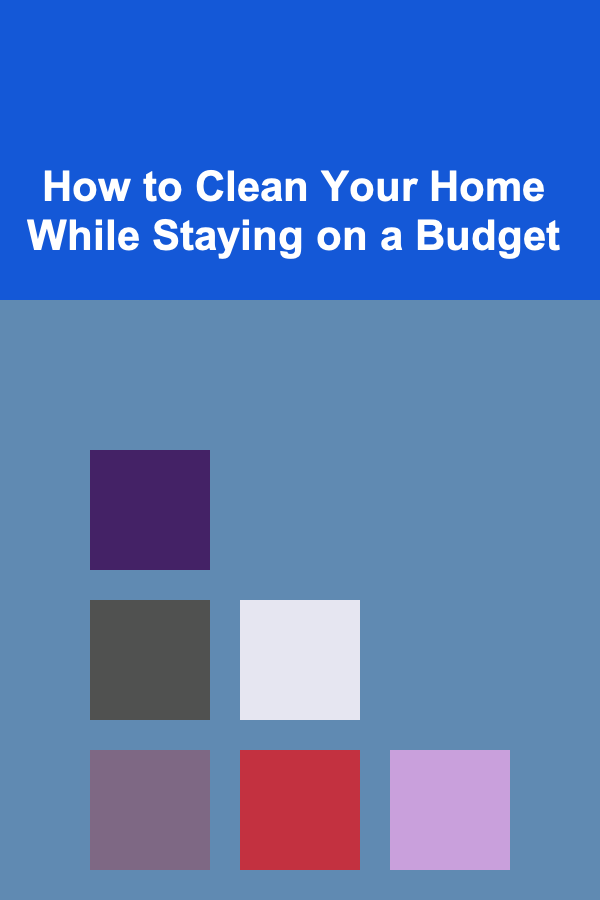
How to Build AR Experiences for Sports Analytics
ebook include PDF & Audio bundle (Micro Guide)
$12.99$11.99
Limited Time Offer! Order within the next:

Augmented Reality (AR) has revolutionized how we interact with digital content, enhancing real-world experiences with immersive virtual elements. In sports, the intersection of AR and sports analytics has opened up exciting possibilities for coaches, athletes, analysts, and fans. From enhancing game-day experiences to improving player performance and tactical decision-making, AR in sports analytics is proving to be a game-changer.
In this article, we will explore how to build AR experiences for sports analytics. We will discuss the potential benefits, essential components, technologies involved, and step-by-step guidance for creating these immersive experiences. By the end of this guide, you will have a clear understanding of how to create effective AR applications for the sports analytics domain.
Understanding AR and Sports Analytics
What is Augmented Reality (AR)?
Augmented Reality (AR) is a technology that superimposes computer-generated images, sounds, or data onto a user's view of the real world. Unlike Virtual Reality (VR), which immerses users in a completely virtual environment, AR enhances the physical world with additional digital content.
AR can be experienced through various devices, including smartphones, tablets, AR glasses, and specialized headsets. In the context of sports, AR can provide real-time overlays of statistics, player movements, game strategies, and much more, giving users a deeper understanding of the game.
What is Sports Analytics?
Sports analytics involves the use of data to gain insights into various aspects of sports performance. This can include player statistics, team performance, injury prevention, and even fan engagement. With advancements in technology, sports analytics has become a cornerstone of modern sports, helping coaches, players, analysts, and teams make data-driven decisions.
Analytics in sports can be divided into several categories:
- Player Analytics: Metrics like speed, stamina, shooting accuracy, and reaction time.
- Team Analytics: Team strategies, passing efficiency, defensive formations, and more.
- Fan Analytics: Engagement metrics such as attendance, in-game behavior, and social media trends.
Combining AR with these analytics opens up a world of new possibilities for visualizing, interpreting, and interacting with data.
The Role of AR in Sports Analytics
AR has the potential to bring sports analytics to life, allowing users to see data and insights in real time. By creating AR experiences for sports analytics, we can enhance the way athletes train, teams strategize, and fans engage with the sport.
Here are several ways AR can improve sports analytics:
1. Real-Time Data Visualization
With AR, athletes and coaches can visualize critical data during the game or training session. For example, during a basketball game, AR can overlay data on a player's shooting accuracy, fatigue levels, or movements on the court. Coaches can receive real-time insights on player positioning and team dynamics through visual cues like heatmaps or trajectory lines, improving their decision-making during the game.
2. Tactical Analysis and Strategy Building
AR allows coaches to project strategies and formations directly onto the field or court. This can be done in practice sessions, where players can see the coach's strategy visualized in real-time through AR glasses or mobile apps. Tactical overlays can include player positioning, defensive structures, offensive plays, and passing patterns, allowing players to better understand and execute complex strategies.
3. Athlete Performance Tracking
AR can enhance athlete performance tracking by providing immersive feedback during training sessions. Coaches and analysts can use AR systems to display player performance data, such as speed, distance covered, or even biomechanics, in real-time. With AR glasses, athletes could receive direct feedback while they are on the field, helping them adjust their technique or performance immediately.
4. Fan Engagement and Spectator Experience
AR can also enhance the fan experience during live games. Fans can use AR apps on their smartphones to access player stats, team statistics, replays, and other immersive content as they watch the game. This enhances their understanding of the game, providing a more interactive and engaging experience. For example, a fan could point their phone at a player and instantly see a detailed breakdown of that player's stats or historical performance.
Key Technologies Involved in Building AR Experiences for Sports Analytics
Building AR experiences for sports analytics requires expertise in both sports data analysis and AR development. Several technologies and tools are involved in creating these experiences, ranging from data collection and analysis to AR development platforms. Here's a breakdown of the key technologies:
1. Data Collection and Analytics Tools
Before integrating AR, you need to gather and analyze the necessary sports data. This requires specialized tools for data collection, including:
- Wearable Technology: Devices like smartwatches, fitness trackers, and motion sensors are used to track an athlete's movement, heart rate, speed, and other physical metrics.
- Computer Vision: Using cameras and sensors to capture player movements and interactions with the environment. This data is processed and analyzed to derive meaningful insights.
- Advanced Statistics Software: Tools like Opta, STATS, or Hudl provide detailed analytics on player performance, team strategy, and game statistics.
- GPS and IoT Sensors: These technologies are used to track player positions on the field in real-time, allowing for enhanced movement and positional analysis.
2. Augmented Reality Development Platforms
AR experiences rely heavily on AR development platforms to build interactive and immersive environments. Some popular AR development tools include:
- Unity 3D with AR Foundation: Unity is a powerful game development engine that also supports AR development. AR Foundation is Unity's framework for building cross-platform AR experiences, supporting both iOS and Android.
- Unreal Engine: Unreal Engine is another widely used game engine that can also create AR experiences. It is known for its high-quality graphics and real-time rendering capabilities.
- ARCore (Google) and ARKit (Apple): These are the primary AR development platforms for Android and iOS devices, respectively. Both ARCore and ARKit provide the necessary tools for building AR applications that interact with the real world.
- Vuforia: A popular AR platform that allows for object recognition, image tracking, and spatial awareness, which are essential for building interactive AR experiences.
- Microsoft HoloLens: For more advanced AR experiences, HoloLens provides a mixed-reality environment that integrates digital content with the real world.
3. Cloud Computing and Edge Processing
Since sports analytics often requires processing large amounts of real-time data, cloud computing and edge processing are critical to ensure smooth and quick data transfer. Cloud computing allows for the storage and processing of vast amounts of data, while edge processing enables faster data processing closer to the source, reducing latency in live sports events.
- Cloud Platforms: AWS, Google Cloud, and Microsoft Azure provide the infrastructure necessary to store, analyze, and distribute sports data.
- Edge Computing: By processing data on local devices (such as smartphones or AR glasses), edge computing reduces delays and ensures that AR experiences remain smooth and responsive.
Building an AR Experience for Sports Analytics: A Step-by-Step Guide
Now that we have a clear understanding of the technologies involved, let's explore the process of building an AR experience for sports analytics. Below is a step-by-step guide to help you develop an effective AR application for this purpose.
Step 1: Define Your Objectives and Audience
Before starting development, you must define the goals of your AR experience and identify your target audience. Are you creating an AR tool for coaches, players, analysts, or fans? What problem are you trying to solve with this AR experience? Understanding the objectives will guide the entire development process.
- Coaches and Analysts: Focus on real-time data visualization, tactical analysis, and performance tracking.
- Athletes: Provide performance feedback, personalized training data, and insights.
- Fans: Enhance game-day experiences with live statistics, replays, and immersive content.
Step 2: Collect and Analyze Sports Data
The next step is gathering the necessary data to inform your AR experience. You will need access to detailed sports analytics, player data, and team statistics. Depending on your focus, this data could come from wearables, sensors, video analysis, or external databases like Opta or STATS.
Make sure the data is clean, accurate, and updated in real time, especially for live sports events.
Step 3: Choose an AR Development Platform
Select the appropriate AR development platform based on your goals and target audience. If you're targeting mobile users, ARKit (for iOS) or ARCore (for Android) may be ideal. For immersive experiences on wearables, HoloLens is a great option.
- For mobile applications, Unity 3D combined with AR Foundation is a powerful and versatile choice.
- If targeting desktop or headsets, consider Unreal Engine or Microsoft HoloLens for more immersive AR experiences.
Step 4: Develop the AR Experience
With your platform selected, begin developing the AR experience. This involves:
- Creating AR Interactions: Develop interactive elements that overlay sports data onto the physical environment. For example, showing player statistics when pointing a device at them.
- 3D Models and Visualizations: If you're visualizing tactics, create 3D models of the field or court to show player movements and strategic overlays.
- Real-Time Data Integration: Set up APIs to pull real-time data from your analytics tools and display it in the AR experience.
Step 5: Test and Iterate
Testing is crucial for ensuring that the AR experience is functional and user-friendly. Test the application in different environments and conditions, including live sports events. Collect feedback from real users---athletes, coaches, and fans---and make adjustments as needed.
Step 6: Launch and Monitor
Once your AR experience is polished, launch it to your target audience. Whether through an app store for mobile devices or as a standalone solution for sports teams, ensure that it is easily accessible. After the launch, continue to monitor usage, gather feedback, and optimize the experience based on user data.
Conclusion
Building AR experiences for sports analytics offers a unique opportunity to enhance how players, coaches, analysts, and fans engage with sports. By integrating real-time data, advanced analytics, and immersive AR technology, you can transform how sports performance is understood and analyzed.
From tactical strategy building to enhancing fan experiences, the potential of AR in sports analytics is vast. By following the steps outlined in this guide, you can create AR applications that provide valuable insights, improve performance, and engage audiences in exciting new ways. As technology continues to evolve, the future of AR in sports analytics looks incredibly promising, with more personalized and dynamic experiences on the horizon.
Reading More From Our Other Websites
- [Home Lighting 101] How to Achieve the Perfect Cozy Ambiance: Living Room Lighting Ideas & Techniques
- [Personal Investment 101] How to Use Fundamental Analysis for Smarter Investment Decisions
- [Sewing Tip 101] Elegant Upholstery Makeovers: Reupholster Chairs and Ottomans on a Budget
- [Home Holiday Decoration 101] How to Create a Holiday Decor Theme Around Your Favorite Tradition
- [Home Storage Solution 101] How to Organize Your Home Office for Peak Productivity
- [Home Security 101] How to Improve Home Security Without Overhauling Your Current System
- [Organization Tip 101] How to Prepare for Inclement Weather on Yard Sale Day
- [Personal Financial Planning 101] How to Start Investing for Retirement with Just $100 a Month: A Beginner's Guide Using Online Brokers
- [Toy Making Tip 101] Plan < Build < Play: A Guide to Thoughtful Toy Creation
- [Beachcombing Tip 101] From Driftwood to Sea Glass: Crafting Souvenirs on a Beachcombing Expedition

Becoming a Successful Product Analyst: Essential Skills for Analyzing Market Trends
Read More
How to Clean Your Home While Staying on a Budget
Read More
How to Create a Home Office Corner in Your Living Room
Read More
How to Set Up Customer Accounts and Manage Orders on Shopify
Read More
When Kids Push Your Buttons: Responding with Calm and Connection
Read More
10 Tips for Securing Grant Funding as a Professor
Read MoreOther Products

Becoming a Successful Product Analyst: Essential Skills for Analyzing Market Trends
Read More
How to Clean Your Home While Staying on a Budget
Read More
How to Create a Home Office Corner in Your Living Room
Read More
How to Set Up Customer Accounts and Manage Orders on Shopify
Read More
When Kids Push Your Buttons: Responding with Calm and Connection
Read More